 |
| Here they come! Iris danfordiae |
Some seed had been waiting a long time and has clearly finished stratifying, such as Tulipa Turkistana, Fritillaria Whitallii (it lost its label to the winter wind but it's definitely a Frit, I can tell by the seed cases still stuck to the end of the grass-like shoots, and I only sowed that, acmopetata (why?) and graeca var something or other and they still have their labels, ergo...). Narcissus serotinus and Rhododendron yunnanense also fall into this category, ie sown in autumn and tucked out of the way till this glorious moment.
 |
| Two to three years later |
What amazes me are the ones that have been out there a month at most and many even less such as the red Delphinium nudicaule, Clematis Ladakhiana and Lathyrus aureus. They're joined by Iris attica, Dianthus arenarius, Primulas laurentiana and alpicola (the white form, I think) and, very excitingly, Digitalis thapsi (sprouting like cress). I say this firstly because it looks like a plant of great merit, combining the best aspects of the flowers of purpurea crossed with a Penstemon, with a more pleasing bushy habit than the former and secondly because it's so crowded up there that I kicked over a pot of thapsi seeds while trying to manoeuvre a sack of compost and hadn't realised I'd bought and sown it twice, such is my voracious appetite for propagation (stop sniggering at the back).
There is also life in the Cyclamen pseudibericum pot but on closer inspection I don't think the seedling is what it said on the tin, being a dicot and having no Cyclamen-like characteristics whatsoever. There are others but I'll have to go out and check when it gets light (I've already bathed, traipsed to the Post Office depot, got second place in the queue and picked up a couple of parcels; infuriatingly I was briefly on the roof taking pictures when the mail came yesterday so it meant a chilly walk in the dark or spending the rest of the morning in a queue there).
But back to those seedlings: of course it does mean a huge amount of that most relaxing and meditative of horticultural tasks: (sarcasm, Americans) pricking out. I spent most of last Sunday afternoon doing the Lewisias - 29, all but the biggest few not really needing it but i'm hopeless at what the packet so casually describes as sowing thinly and evenly. Especially when the seeds are black and would happily pass through the eye of the finest needle. So before they grew into one big clump of cruciforms I got my domestic fork out and went for it. I'd better get lots of yellows, peaches and oranges for my efforts.
 |
| One down, 28 to go... |
Fortunately bulb seedlings should remain undisturbed for two years because there are literally 100 young Gladiolus tristis in their tray, I think every single seed must have germinated - no wonder it can become a weed in warmer climes. The tray's not really deep enough for two years' life but with their remarkable zest they'll find a way. It will be interesting to see what comes up in the Lily pot, which is deep enough (about 15cm) besides the few true leaves and odd cotyledon already there (a lot withdrew during the winter but will hopefully return). I suspect I might get another flush of juniors, as often happens with mixed bags.
Speaking of bulbs, I've managed to work out that Calochortus flower after their leaves mature. Which would explain all the thick, grassy leaves and distinct lack of bloomage. While C. 'Cupido' has been outside all winter and looks none the worse for it, C. venustus is slightly more tender and spent the winter at the bottom of the stairs, an area we don't heat and where all efforts at insulation and draught exclusion have been met with a shiver and is, as my friend Roger would say, as cold as a witch's tit (apologies now to witches everywhere, it was a quote taken out of context and I will not be offering my resignation. Some of my best friends are witches). It is, nonetheless, in rude health with leaves about 10cm high so I've been hardening it off, bringing it in at night. Exactly the same treatment has been given to Gladiolus byzantinus and the thrilling Dichelostemma ida-maia, a proper exotic! Both are showing a couple of centimetres of growth.
Ornithogalum nutans (yes, I have a bulb problem, fuck knows what I'll do if even half the South African stuff germinates) is biding its time but Leucocoryne purpurea, in the cold greenhouse, has a couple of shoots that I'm sure sprang up overnight.
 |
| From those, should come... |
 |
| ...Something like this. Surely too beautiful to be hardy in the UK? |
So I said I picked up a few parcels: one was a systemic fungicide I should have bough last year given the devastation wrought by rot on my Pelargonium species in the greenhouse (ironically the cold was no problem at all, something that might save my species Gladioli, Moraea and other borderline hardy bulb ambitions.
There were also three Lilium pumilum (tenuifolium) bulbs from Pottertons. I must have ordered these months ago because that's the fourth lot! And they're meant to be rare! Also in there was a supremely healthy looking Rhododendron radicans in a 10cm pot. This would appear to be an old name for R. calostrotum ssp. keleticum, which I got in a recent goody box from someone else. However, it's the smallest species yet discovered so I should be able to accommodate both. The Pottertons specimen in particular is just too healthy and sexy to give away!
I might have to give away the Lily bulbs though as things in that department have reached saturation point. I've been thinking about how to provide colour round the lower parts of the plants and also when they finish blooming. I ordered nasturtiums last autumn to plant at the base because they gave an amazing late, late show last year but they're not self-supporting so I've also sent off for seeds of a red Ipomea and also have tropical looking, half-hardy Mina lobata seeds so that should provide a tangle of vulgarity, in the best possible taste! I would have gone with sweet peas but they always seem to attract aphids like flies to a fresh cowpat. My nasturtiums always get blackfly but seem to be strong enough to shake them off (with a little help from organic spray).
 |
| Mina lobata. Something to look at when the Lilies have passed - and hopefully cover the stems too because they must be left to build up a bulb for next year |
Not content with amassing a collection of the world's Lily species and quite a few hybrids too, I've also develped a fixation with growing bulbs from seed. The problem is most of the interesting ones are borderline hardy to tropical, ie, completely unsuitable for a London rooftop where everything is container grown, exposed to frost and, today at least, a biting wind. You already know about my pointless gathering of Gladioli and Moraea seesUndeterred I did a bit of investigation and found that Chile, the world's longest beach, also contains the world's longest mountain range and it is up there that some very beautiful and, more importantly, hardy, bulbs and other plants grow. Even better there is a mail order firm there that specialises in selling seed of many Chilean species and they really know their stuff. Having said that my order hasn't arrived yet and they are a bit on the pricey side but Chileflora.com has a huge range of seed from trees to succulents to medicinal plants to BULBS!
So I put in my order, using the extensive info on the site to make my choices as most are extremely obscure and the should be dropping through the letter box any day now.
And if my magic germination touch continues I should be the proud owner of (I'm sure they won't mind me using their pictures since I recently sent them £40!
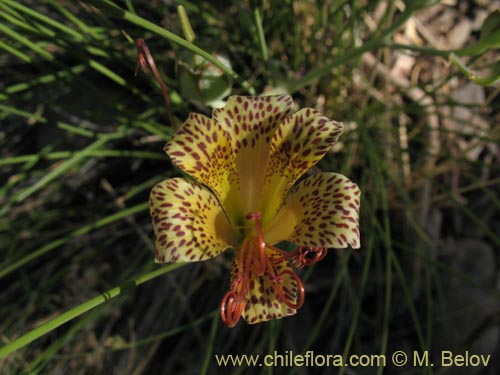 |
| Alstroemeria versicolor |
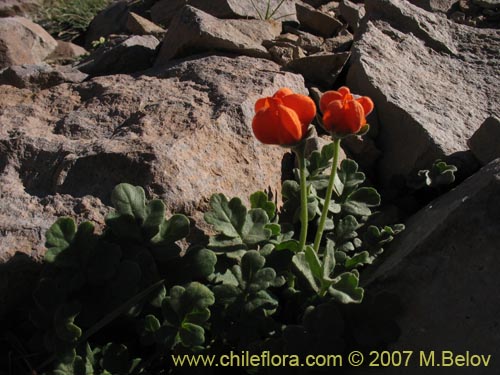 |
| Loasa lateritia |
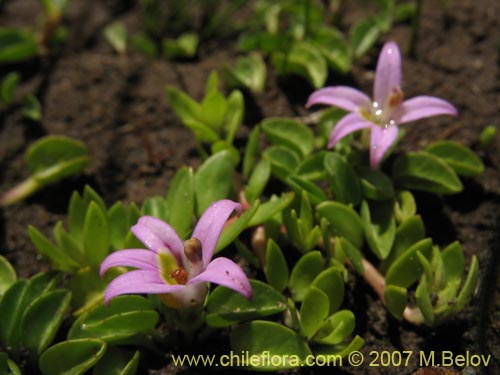 |
| Lobelia oligophylla |
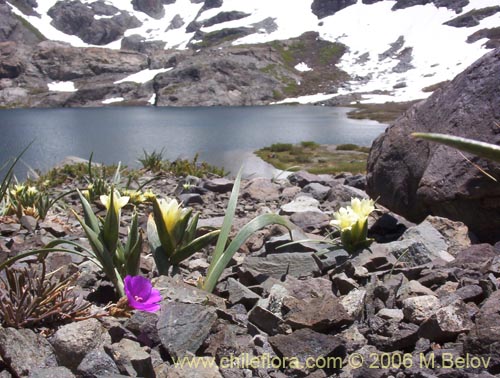 |
| Montiopsis sp.#42 (unfortunately it's the purple one, not the intriguing cream flowers) |
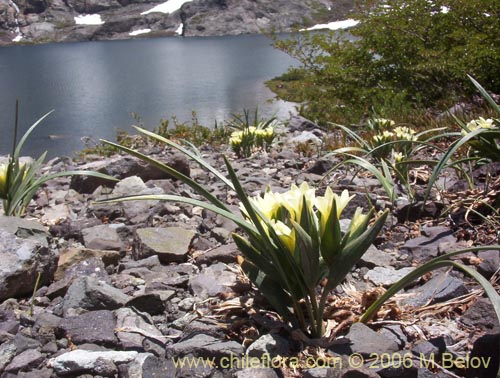 |
| So I ordered them too, they're called Olsynium frigidum but look a bit like Caucasian Tulips |
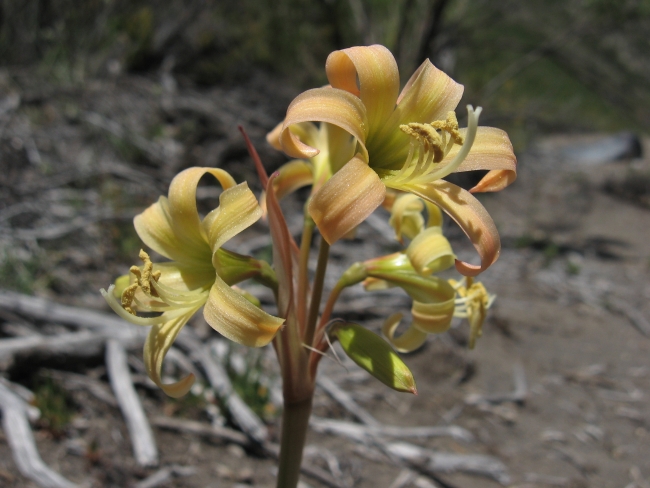 |
| Rhodophiala montana |
 |
| Rhodophiala Splendens |
 |
| Schizanthus coccineus |
I got the post man today although there's nothing exciting except 100 orange plant labels (I fancied a change) and, just in time, a "widget, dibber [and more, white] label set" for pricking out. The widget looks really useful actually, better than the old dining fork I was using!
Now, bit of a disaster in the "greenhouse" where my species Pelargonium seedlings have been over-wintering, along with various other neglegted things. All my Salvia patens cuttings have died due to neglect although the Penstemons are okay (but then so are the ones outside). So the arrival of the fungicide this morning was timely, if a little late as the three "survivors" looked like this:
 |
| Oh dear. |
 |
| Now that's fungus! |
Finally, I had a couple of clay pans that I'd rescued from Scotland lying around taking up room and a bag of free mixed narcissus doing the same so I decided to unite one of the pans with the surviving bulbs, which are already growing in that cheapest of growing mediums - air, packing them in as I'm not planning on nurturing them, just let them flower one year and chuck 'em because there is a hell of a lot in the queue to replace them! But they'll add a splash of colour to the tulips on the windowsill that I'm also growing in that wasteful manner. Pelargoniums, regal and species, will replace them although everyone eill hopfully be looking at the Lilies!
For the other pan I bought a mixed bag of red Glads, Freesias and Anemones for a quid or so. The Glads went in first as they'll need the most support:
 |
| Then the Freesias... |
 |
| No, not raisins, Anemones. Don't bother trying to work out which way up they go, it's impossible. Just spread them evenly over the compost, cover, water and wait. |
And finally, for those of you who have been wondering about the black primula, Primula euprepes SDR6036, it's still with us. I thought i was going to lose it to rot, and the central rosette did require whipping out but there are several very healthy ones clustered round it. And just to prove it...
Sorry this post was so long in coming, I'll try to keep them more regular but it's a bit weird spending your days off doing your day job!
Start sowing, keep growing and ENJOY YOUR GARDEN!
The Plantboy







No comments:
Post a Comment